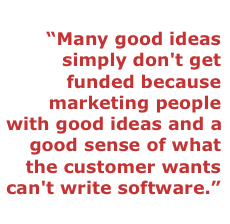
Hey Bay Area! Â It’s nice to be blogging to a Bay Area audience again, after all these years. I started my web-design company in 1994 on High Street in Palo Alto, moved it to San Francisco, and Studio Verso was part of the burrito-filled heyday of Web 1.0. Back then, venture capitalists were busy helping entrepreneurs figure out what the web was all about. I remember words like “disambiguation” and B2B, and I remember how surprised we all were when Amazon.com started selling things other than books. It was a great time to be an entrepreneur.
Fast forward to today, where I think we have a problem with venture capital. Today, the typical VC today is moving “up the foodchain” to bigger and later deals, while the angels have flown in by the Cayenne-load to fill the gap left behind. And now there are more organized groups of angels acting like VCs than even Ron Conway can count (and he can count to a google). But there’s still a problem.
Check out any of these groups and you’ll hear a lot of the same thing. Dave McClure, of 500 Startups, has written about how investing is changing. They span the range from Paul Graham’s excellent Y-combinator to larger funds like Accel and Charles River writing small checks. In the middle are a few seriously competent funds, like First Round Capital and Ron Conway’s new Angels fund. These first rounds are often in the range of $200k – $500k. And yet, all angels and VCs alike pretty much agree on one thing. Venture capitalist Mark Suster sums it up when he says you need momentum to get other people’s money. Momentum. Traction. Visitors. Registered users. Customer adoption. Dogs eating the dog food. This is what all funds, large and small, are looking for. Which means you need to build something small and launch it without any capital at all, or from your dorm room while you skip classes, or with rent money paid by family and friends.
Think about what that means. It means that engineers are the ones getting the money. Only a software engineer has time to build something in her spare time or in a few months after being laid off. Even asking for two engineers to work together without getting paid significantly reduces the number of teams that can get any traction.
I have spent most of the last 30 years coming up with ideas for companies and talking with people about them, or helping people with their ideas. And what I have found over and over again is this: Technology isn’t the big problem. Marketing is the big problem. It’s not really that hard to write and launch an application – the trick is to get people to like it and tell their friends about it.
Engineers Suck at Marketing
As an example, look at RichTweets.com – this is a service from an engineer who has a great idea. He realizes that the 140-character limit on tweets is silly, and if you include all the @names, #hashtags, and http:// bullshit, not to mention leaving room for other people to RT, you have about 70 characters to work with, so people end up writing lines of Twitter code that’s “2 tuf 2 rd”. Furthermore, it leads to mistakes, semantic dispersion, insane link shortening, and generally works against anyone or any program trying to assemble all the information coming down about a given topic. Why do that when computers can help us make short messages that carry information on two levels – visual for humans and semantic for machines? HTML is designed to bury the link structure and give you a choice of fonts, bold, italic, and other typographic choices. So a rich tweet really is a huge improvement over today’s ridiculous coded messages. RichTweets should have been funded a hundred times, but it wasn’t, and no one knows about it. Why? Because the nice guy who built it is a programmer who lives in Germany and who doesn’t happen to party with the sharp marketing people who live in Dogpatch lofts.

It Takes a Team
There are thousands of apps like this that don’t have traction – not because they suck, but because their creators suck at marketing. The few engineers who have wealthy relatives and manage to team up with decent marketing people or get lucky are those who have traction. And this is probably why so many startups that get traction give such poor user experiences – because the engineer who managed to meet a marketing person who would work for free didn’t also happen to meet a designer who also works for free. That’s why sites like Craigslist, eBay, GoDaddy, and many others are such disasters, with bad design at the core of their corporate cultures that continues well past going public.
The ideal team to start a company around a good idea is:
- a great coder
- a great marketing person
- a good designer
- someone who understands that treating every customer like gold and offering maniacally great customer service is as important as everything else combined
I think the VCs and the super angels have it wrong. I claim you can outsource #1 and #3, but you can’t outsource #2 and #4.
The Marketing End is the Business End
Many good ideas simply don’t get funded because marketing people with good ideas and a good sense of what the customer wants can’t write software. I believe that many of our upcoming technological breakthroughs could be created much more efficiently if marketers were allowed to dream big and hook up with programmers who could find a way to build them.
And that costs a little money. Listen to Naval – he says you can do marketing on Twitter and Facebook as if it were trivial (he doesn’t mean that, I’m sure, but he glossed over it in seconds in that talk). He’s right that it’s getting cheaper and cheaper to build software, but I don’t see it getting cheaper and cheaper to get hundreds of thousands or millions of users. In fact, while software development costs have come down dramatically, customer acquisition costs haven’t changed much at all. Yes, people are more connected and send more messages. But there’s also more noise and confusion than ever: consumers don’t want another log-in or another account or another “solution” for anything. They get bombarded by too many pitches for companies trying to help them, only to learn that the companies are really trying to help themselves. How many companies say “Follow us on Twitter!†“Visit us on Facebook!†Can you just hire a social marketing expert, buy some keywords, and watch your sales go through the roof? I don’t think you can.
Getting people to use something that can save them time, make their lives better, or even save them money for the cost of changing behavior is one of the most difficult challenges in business – always has been, and always will be.
Marketing Fuel is Super Fuel
In the current environment, investors are sending a clear message: “Engineers, build something cool, make a video, put it on YouTube, and pray you get lucky (as Word Lens did). If it doesn’t magically get traction, build something else and try again.â€
I would buck that trend. If I had a fund, I wouldn’t fund anything with traction. I would have a big space where people could come co-work and hang out and kick ideas around, with free coffee, juice, muffins, and games. I would do the same thing online (first have to invent virtual muffins). And, if a killer marketing person with a radical idea happened to meet a fantastic technology person who could see a clever way to build it, I would give them what they needed to quit their day jobs. I’d give them enough fuel to launch and iterate and adapt to the realities of the market, without having to go beg for money in the middle of the process and put the venture at risk. While the other super angels are all fighting over the same momentum-fueled deals, I’d be building companies from scratch, the old fashioned way, one customer at a time. A few of them, I bet, would get momentum.
It might cost a bit more money initially, when things are more risky, but a good marketing person is going to be a more solid bet than a good entrepreneur who has to pivot and raise more money later. I would rather read market-requirements documents and marketing plans than business plans any day. I can fix the financials and operations if I have to. I can bring in a CTO or outsource the coding to a well organized development team. I would rather be talking at 2am about points of customer resistance and business development deals than about PHP vs Ruby. Show me an MRD that identifies the natural energy of customer pull at its source and a marketing plan to get the message out, and I’ll show you someone who’s going to succeed one way or another.
But then, no one is going to give me the money for such a fund, because … well, because I don’t have any traction.
You can read David Siegel’s biweekly blog at www.thepowerofpull.com and get his book, Pull, at any book dealer or at Amazon.com for your Kindle.


